Turn Up Your Speakers
St. Patrick's
Day
Enjoy the following history, legends, stories and traditions
of St. Patrick, Leprechauns, the Blarney Stone, Fairies,
the Claddagh
Ring, the Pot of Gold and St. Patrick's Day.
THE LEGEND OF ST. PATRICK
St. Patrick is known as the patron saint of Ireland.
Although, Patrick was not a born Irish, he's an important part of the Irish heritage, mostly through his service
in Ireland in the 5th century.
Patrick was born sometime during the 4th century AD. There are contradictory
dates about 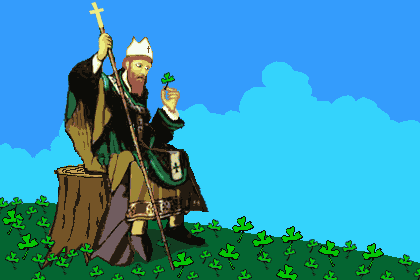 the exact year and place of his birth. One
opinion is that he was born about 390 A.D., while others say it is 373 A.D.
and still others say he was born in Wales in 385 A.D. His birth place is said to be in either
Dumbarton in Scotland, Wales or Roman England and his real name was probably Maewyn
Succat. Though Patricius was his Romanicized name, he was later known as Patrick.
the exact year and place of his birth. One
opinion is that he was born about 390 A.D., while others say it is 373 A.D.
and still others say he was born in Wales in 385 A.D. His birth place is said to be in either
Dumbarton in Scotland, Wales or Roman England and his real name was probably Maewyn
Succat. Though Patricius was his Romanicized name, he was later known as Patrick.
Patrick was the son of Calpurnius, a Roman-British army officer. One day
during his youth in Britain a band of pirates (Niall of the Nine Hostages
who was to become a King) landed in South Wales and kidnapped him along with many others.
He was then sold into slavery and worked as a shepherd in Ireland.
He was imprisoned there for six years. This
is the time when his life changed. He dreamed that he had seen God. Legend says, he was
directed by God to escape with a getaway ship. He traveled over 200 miles
from his Northern captivity to Wexford town where, sure enough, a ship was
waiting to enable his escape. Upon arrival in England he was
captured by brigands and returned to slavery.
He escaped after two months to Gaul, (present
day France) and spent the next seven years
traveling Europe seeking his destiny.
He studied Christianity in the Lerin Monastery in France, then joined a monastery and studied under St.
Germain, the bishop of Auxerre. He spent about 12 years there in training.
He dreamed that the Irish were calling him back to Ireland to tell them about God.
His wishes were to return to Ireland but his superiors instead appointed St. Palladius.
Two years
later, Palladius transferred to Scotland. Patrick was then appointed as second bishop to Ireland.
There he converted the Gaelic Irish, who were then mostly Pagans, to Christianity.
He was confident in the Lord, he journeyed far and wide, baptizing and confirming with untiring zeal.
And, in a diplomatic fashion he brought gifts to a kinglet here and a lawgiver there, but accepted none from
any.
 Indeed, Patrick was quite successful at winning converts. Through active preaching, he made important converts even among the royal families.
This fact upset the Celtic Druids. Patrick was arrested many times, but
always escaped. For over 20 years he traveled throughout Ireland, establishing monasteries across the country. He
set up schools and churches which would aid him in his conversion. He developed a native clergy, fostered the growth of
monasticism, established dioceses, and held church councils.
Patrick's doctrine is considered orthodox and has been interpreted as
anti-Pelagian. Although he is not particularly noted as a man of learning, a few of his writings remain extant:
his Confession, a reply to his detractors, and several letters. The Lorica ("Breastplate"), a famous hymn attributed to
Patrick, may date to a later period.
Indeed, Patrick was quite successful at winning converts. Through active preaching, he made important converts even among the royal families.
This fact upset the Celtic Druids. Patrick was arrested many times, but
always escaped. For over 20 years he traveled throughout Ireland, establishing monasteries across the country. He
set up schools and churches which would aid him in his conversion. He developed a native clergy, fostered the growth of
monasticism, established dioceses, and held church councils.
Patrick's doctrine is considered orthodox and has been interpreted as
anti-Pelagian. Although he is not particularly noted as a man of learning, a few of his writings remain extant:
his Confession, a reply to his detractors, and several letters. The Lorica ("Breastplate"), a famous hymn attributed to
Patrick, may date to a later period.
By the end of the 7th century Patrick had become legendary, and the legends have continued to grow
ever since. There are many legends associated with St. Patrick. It's said that he used the
three-leafed shamrock to
explain the Trinity. He used it in his sermons to represent how the Father, the
Son, and the Holy Spirit could all exist as separate elements of the same
entity. Hence its strong association with his day and name.
Much Irish folklore surrounds St. Patrick's Day. Not much of it is actually substantiated.
Some of this lore includes the belief that Patrick raised people from the dead. He also is said to have given a sermon from a hilltop that drove all the snakes from Ireland. Of course, no snakes were ever native to Ireland, and some people think this is a metaphor for the conversion of the pagans.
True, these are mostly legends. But, after some 1500 years, these legends have been inseparably combined with the facts. And together they have helped us know much about the Saint and the spirit behind celebration of the day.
Patrick was once tempted by the Devil whilst on a
pilgrimage at Croagh. For his refusal to be tempted, God rewarded him
with a wish. Patrick asked that the Irish be spared the horror of Judgement Day
and that he himself be allowed to judge his flock. Thus, the legend that Ireland
will disappear under a sea of water seven years before the final judgement, was
born.
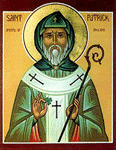 His mission in Ireland lasted for thirty years. After that time, Patrick
retired to County Down. Patrick died on March 17, A.D. 461 at the age of 76.
It is not known for sure where his remains were laid although Downpatrick in
County Down in the North of Ireland is thought to be his final resting place. That day has been commemorated as St. Patrick's Day ever since.
The day's spirit is to celebrate the universal baptization of Ireland. Though originally a Catholic holy day,
St. Patrick's Day has evolved into more of a
secular holiday. Or, rather, 'be an Irish Day ' and the Irish
consider it as part of their national tradition everywhere they populated and prospered. The Catholic feast day for this most loved of Irish saints has become a holiday
in celebration of the Irish and Irish culture. Along with St. Patrick, the
leprechaun,
a Celtic fairy, has become entrenched as a chief symbol for this holiday, as
is the shamrock, an
ancient symbol for the triple goddess
Brigit. It is fitting that this holiday should fall at the time of the year
when the return of spring begins to seem at hand.
His mission in Ireland lasted for thirty years. After that time, Patrick
retired to County Down. Patrick died on March 17, A.D. 461 at the age of 76.
It is not known for sure where his remains were laid although Downpatrick in
County Down in the North of Ireland is thought to be his final resting place. That day has been commemorated as St. Patrick's Day ever since.
The day's spirit is to celebrate the universal baptization of Ireland. Though originally a Catholic holy day,
St. Patrick's Day has evolved into more of a
secular holiday. Or, rather, 'be an Irish Day ' and the Irish
consider it as part of their national tradition everywhere they populated and prospered. The Catholic feast day for this most loved of Irish saints has become a holiday
in celebration of the Irish and Irish culture. Along with St. Patrick, the
leprechaun,
a Celtic fairy, has become entrenched as a chief symbol for this holiday, as
is the shamrock, an
ancient symbol for the triple goddess
Brigit. It is fitting that this holiday should fall at the time of the year
when the return of spring begins to seem at hand.
The St. Patrick's Day custom came to America in 1737. That was the first year
St. Patrick's Day was publicly celebrated in this country, in Boston.
The Emerald Isle is one of the largest islands in the world. It is located west
of Great Britain. Heavy rain creates the lush, fertile, green land. Several
lakes and rivers reside in Ireland; the longest river is the Shannon. (click
map for enlargement)
Capital: Dublin
Area: 27,136 square miles
Languages: English and Gaelic
National Day: March 17th
National Anthem: The Soldier's Song
POTATOES AND IRELAND
In 16th century Ireland, Sir Walter Raleigh began cultivating the potato on
his property, which rapidly gave way to the potato cuisine.
The Great Potato Famine
In the late 1850s, a potato famine devastated Ireland. Almost a million people
succumbed to starvation and disease. The potatoes were infected with Late
Blight, a serious fungal disease.
 The
Potato Eaters
The
Potato Eaters
1885 (180 Kb); Oil on canvas, 81.5 x 114.5 cm; Rijksmuseum Vincent van Gogh,
Amsterdam
Of
this painting van Gogh wrote to his brother Theo:
`I
have tried to emphasize that those people, eating their potatoes in the
lamp-light have dug the earth with those very hands they put in the dish, and so
it speaks of manual labour, and how they have honestly earned their food'.
THE IRISH FLAG

The tri-color flag of
Ireland was based on that of France and was first used in 1848.
The green represents the Catholic, Gaelic and Anglo-Norman communities, the
orange represents the planter group of Northern Ireland while the white center
section signifies a hope of peace and trust between the two.
Erin-Go-Bragh Flag
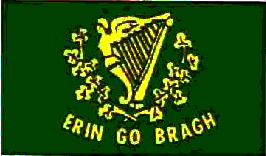
The Erin-go-bragh flag, sometimes called the Irish-American flag features a gold harp surrounded by clover with the words Erin-go-bragh on a field of green. Versions of this flag were carried by Irish regiments in the Civil War.
Four Provinces Flag
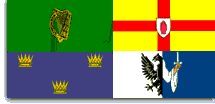
The Four Provinces flag. Each quadrant of this flag features a different Irish province.
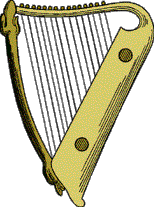 THE HARP
THE HARP
The harp of the small portable type played by Celtic minstrels, is the oldest official symbol of Ireland. Though not as recognizable as the shamrock, the harp is widely used. It appears on Irish coins, the presidential flag, state seals, uniforms, and official documents. But the harp is most often associated with Guinness, which adopted the harp as its trademark in 1862.
LEPRECHAUNS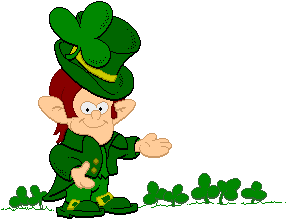
Cluricauns are cousins to the leprechauns. They look very similar with a few variances - silver buckles, pink noses, blue stockings . . . . Unlike leprechauns, cluricauns do not like to work, they are in fact quite lazy. They would much prefer to drink wine barrels until empty.
FAIRIES
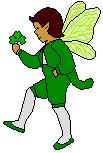 Fairies
are small supernatural creatures of human form. They live in everyday
surroundings. They are generally thought to be beneficial to humans. However,
they are known to play pranks and it is best to treat them with respect. They
are small, beautiful, airy, nearly transparent in body, and can assume any form.
In Ireland fairies are called Sidhi, (pronounced "shee").
Fairies
are small supernatural creatures of human form. They live in everyday
surroundings. They are generally thought to be beneficial to humans. However,
they are known to play pranks and it is best to treat them with respect. They
are small, beautiful, airy, nearly transparent in body, and can assume any form.
In Ireland fairies are called Sidhi, (pronounced "shee").
Fairies, as we know them today, are the ancient remnants of the Tuatha de
Danaan, which means the people of the goddess Anu. Anu being like Mother Earth,
the Tuatha were the gods and goddesses of the various aspects of nature. Like
Nature itself, some were good and some were pretty frightening. With the onset
of Christianity, these creatures, while still a rich part of Celtic myth and
legend, grew considerably less forbidding and less powerful over the centuries
becoming the whimsical, ethereal, airy, creatures we think of today.
Other fairies include the
wicked Sheoques, which are known for switching human babies with changelings.
The Leanhaun Shee fairy seeks the love of human males. Those who fall under her
spell are doomed to waste away, however those who refuse her make her their
slave. The Banshee is a female fairy who calls to those about to parish. Then
there is the Fear Gorta who if you bring food to will bless you with good luck.
There are many types of fairies even those who live in the home and nearby wells
all with special names and habits.
THE BLARNEY STONE
The Blarney Stone is a stone set in
the wall of the Blarney Castle tower in the Irish village of Blarney. Kissing
the stone is supposed to bring the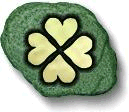 kisser the gift of persuasive eloquence
(blarney). The castle was built in 1446 by Cormac Laidhiv McCarthy (Lord of
Muskerry) -- its walls are 18 feet thick (necessary to thwart attacks by
kisser the gift of persuasive eloquence
(blarney). The castle was built in 1446 by Cormac Laidhiv McCarthy (Lord of
Muskerry) -- its walls are 18 feet thick (necessary to thwart attacks by 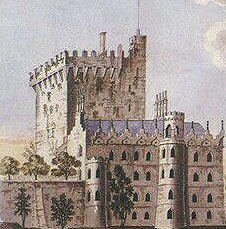 Cromwellians and William III's troops). Thousands of tourists a year still visit
the castle. The origins of the Blarney Stone's magical properties aren't
clear, but one legend says that an old woman cast a spell on the stone to reward
a king who had saved her from drowning. Kissing the stone while under the spell
gave the king the ability to speak sweetly and convincingly. It's tough to
reach the stone -- it's between the main castle wall and the parapet. Kissers
have to stretch to their back and bend backward (and downward), holding iron
bars for support. Legend holds that
anyone who kisses the stone shall receive the gift of gab (persuasion).
Cromwellians and William III's troops). Thousands of tourists a year still visit
the castle. The origins of the Blarney Stone's magical properties aren't
clear, but one legend says that an old woman cast a spell on the stone to reward
a king who had saved her from drowning. Kissing the stone while under the spell
gave the king the ability to speak sweetly and convincingly. It's tough to
reach the stone -- it's between the main castle wall and the parapet. Kissers
have to stretch to their back and bend backward (and downward), holding iron
bars for support. Legend holds that
anyone who kisses the stone shall receive the gift of gab (persuasion).
THE POT OF GOLD
How the leprechaun with his pot o' gold
hidden at the end of the rainbow got tied  into
St. Patrick's Day is not clear. It is probable that in St. Patrick's Day
celebrations, in searching for Irish customs and history, the myths got dragged
in as well. However, there is an interesting
note about the leprechaun hiding his gold at
the end of the rainbow...he may be a myth, but he's no dummy. There is no end of
a rainbow, as rainbows are actually circles. It's just that we can only see part
of it at a time, so to our perception it is an arc or bow.
into
St. Patrick's Day is not clear. It is probable that in St. Patrick's Day
celebrations, in searching for Irish customs and history, the myths got dragged
in as well. However, there is an interesting
note about the leprechaun hiding his gold at
the end of the rainbow...he may be a myth, but he's no dummy. There is no end of
a rainbow, as rainbows are actually circles. It's just that we can only see part
of it at a time, so to our perception it is an arc or bow.
POT OF GOLD STORY
Once upon a time, there was an old
couple. They were very poor and didn't have enough food. Their only possessions
were a few ragged clothes and a big, shiny, black cooking cauldron.
One day, the man went to look for jobs in the
village while his wife worked in their small vegetable garden. The work was hard
for her, as she was getting old. Tired and hungry, she made a feeble attempt to
pull a tiny carrot from the ground.
"What are you doing?" a tiny voice
cried.
The lady sat up, startled. "Who's
that?" she asked, looking around.
"Look down, miss. I'm a leprechaun!"
the voice cried, louder. She looked down and gasped. Shaking dirt off himself,
was a small leprechaun.
He got up and skipped towards the couples' tiny
one-room house. The lady followed him.
Settled on their table, crudely made of chopped
wood, the leprechaun told the lady why he was there. "You see, I have come
to grant one wish to you and your husband. You must think very hard and
carefully about it and I will be back tomorrow to grant it." With that, he
ran out of the house and disappeared.
The man and woman talked about their wish all
night but couldn't come to a conclusion. There were so many things they needed.
When morning came, they were exhausted. When they
heard the leprechaun's tiny voice "I'm back to grant your wish!", they
moved around excitedly.
"What would you like?"
"Money!" was the wife's reply.
"Riches, gold and silver..."
"Tools, a proper house, a job, so many
things..." the husband answered.
"Oh, and clothes! Beautiful fashions!"
from the wife.
"YOU ARE BEING SELFISH!" the leprechaun
screamed.
All conversation came to a sudden halt. The
husband and wife looked expectantly at the "For this, I will not grant any wish of
yours. But, since you are in need, I will give you a hint. I have hidden a pot
of gold at the end of the rainbow. All you have to do is find it."
The man and woman looked at each other,
excitedly.
"We must go, now! Quickly!" the man
cried, rushing out of the house. "Come on!" she gestured madly at his
wife.
She nodded and they took off into the horizon,
searching for the gold.
They are still searching and rumor has it that
there actually is a pot of gold at the end of the rainbow!![]()
 leprechaun.
leprechaun.
 The Shamrock
The Shamrock
HISTORY OF SHAMROCK
This is the national flower of Ireland. The word shamrock comes from the Gaelic word seamrog, which means "trefoil" or "little clover". The shamrock has the ability to foretell the future: when it is about to rain the leaves turn upwards. The lucky four leafed clover is difficult to find because it is actually a genetic abnormality that causes the fourth leaf. One legend states that St. Patrick used the shamrock to explain the Trinity (a basic principle of the Catholic faith) He is said to have illustrated the existence of the Three in One by plucking a shamrock from the grass growing at his feet and showing it to his congregation. "Do you not see," he said, "how in this wildflower three leaves are united on one stalk, and will you then believe that there are indeed three persons an yet one God?". According to David Plotz, Slate's Washington bureau chief, "this is an 18th century fabrication".In written English, the first reference to the Shamrock dates from 1571, and in written Irish, as seamrog, from 1707. As a badge to be worn on the lapel on the Saint's feast day, it is referred to for the first time as late as 1681. The Shamrock was used as an emblem by the Irish Volunteers in the era of Grattan's Parliament in the 1770's, before '98 and The Act of Union. So rebellious did the wearing of the Shamrock eventually appear, that in Queen Victoria's time Irish regiments were forbidden to display it. At that time it became the custom for civilians to wear a little paper cross colored red and green.
As a symbol of Ireland it has long been integrated into the symbol of the United Kingdom, along with the Rose, the Thistle and the Leek of England, Scotland and Wales. So today, on St. Patrick's Day, a member of the British Royal Family presents Shamrock to the Irish Guards regiment of the British Army.
THE MAGIC SHAMROCK 
Three is Ireland's magic number. Hence the Shamrock. Crone, Mother
and Virgin. Love, Valour and Wit.. Faith, Hope and Charity. Father, Son and Holy
Spirit. Numbers played an important role in Celtic symbolism. Three
was the most sacred and magical number. It multiplies to nine, which is sacred
to Brigit. Three may have signified totality: past, present and future OR
behind, before and here OR sky, earth and underworld. Everything good in
Ireland comes in threes. The rhythm of story telling in the Irish tradition is
based on threefold repetition. This achieves both intensification and
exaggeration. Even today in quality pub talk, a raconteur can rarely resist a
third adjective, especially if it means stretching a point. "Three
accomplishments well regarded in Ireland: a clever verse, music on the harp, the
art of shaving faces."
 The Claddagh Ring
The Claddagh Ring
Legend tells of a man, from Claddagh, who
was captured by pirates a week before he was to be married. While he was
enslaved, he learned to be a goldsmith. He created a ring for the bride he
longed to see again. The heart in the center symbolized their love, the hands
holding the heart symbolized their friendship, and the crown represented their
loyalty. He did indeed return to his bride, gave her the ring, and married her.
Today, tradition follows that if you are given this ring in friendship the heart
points outward; if given in love, the heart points inward.
Irish Blessings
![]()
Near a misty stream in Ireland in the hollow of a tree
Live mystical, magical leprechauns
who are clever as can be
With their pointed ears, and turned up toes and little coats of green
The leprechauns busily make their shoes and try hard not to be seen.
Only those who really believe have seen these little elves
And if we are all believers
We can surely see for ourselves.
(Irish Blessing)
Cead Mile Failte
One hundred thousand
welcomes
![]()
Erin Go Braugh
Ireland Forever
May your blessings
outnumber the shamrocks that grow,
And may trouble avoid you wherever you go.
May the road rise up to meet you,
May the wind be always at your back,
May the sun shine down upon your face,
And the rain fall soft upon your fields,
Until we meet again,
May God hold you in the hollow of his hand.
-Irish Blessing
![]()
Up the airy mountain
Down the rushy glen,
We daren't go a-hunting
For fear o' little men
-William Allingham
May the Irish hills
caress you.
May her lakes and rivers bless you.
May the luck of the Irish enfold you.
May the blessings of Saint Patrick behold you.
-Irish Saying
![]()
'Tis better to buy a
small bouquet
And give to your friend this very day,
Than a bushel of roses white and red
To lay on his coffin after he's dead.
-Irish Saying
Green are the hills of
Ireland,
And green they will always stay.
Warm are the blessings wished for you,
And they'll always stay that way.
-Irish Blessing
![]()
May St. Patrick guard
you wherever
you go and guide you in
whatever you do--and may his loving
protection be a blessing to you always.
-Irish Blessing
May the saddest day of
your future be no worse
than the happiest day of your past
.-Irish Saying
![]()
"May your blessings
outnumber
the shamrocks that grow
And may trouble avoid you
wherever you go."
-Irish Blessing
May there always be work
for your hands to do,
May your purse always hold a coin or two.
May the sun always shine warm on your windowpane,
May a rainbow be certain to follow each rain.
May the hand of a friend always be near you,
and may God fill your heart with gladness to cheer you.
-Irish Blessing
![]()
May your glass be ever
full.
May the roof over your head be always strong.
And may you be in heaven half an hour before the devil knows you're dead.
-Irish Toast
![]()
![]()
![]()
![]()
![]()
Visit our Greeting Card Museum to see Vintage
St. Patrick Day Cards
Copyright ©Emotions Greeting Cards a division of VH Productions 2000-2003